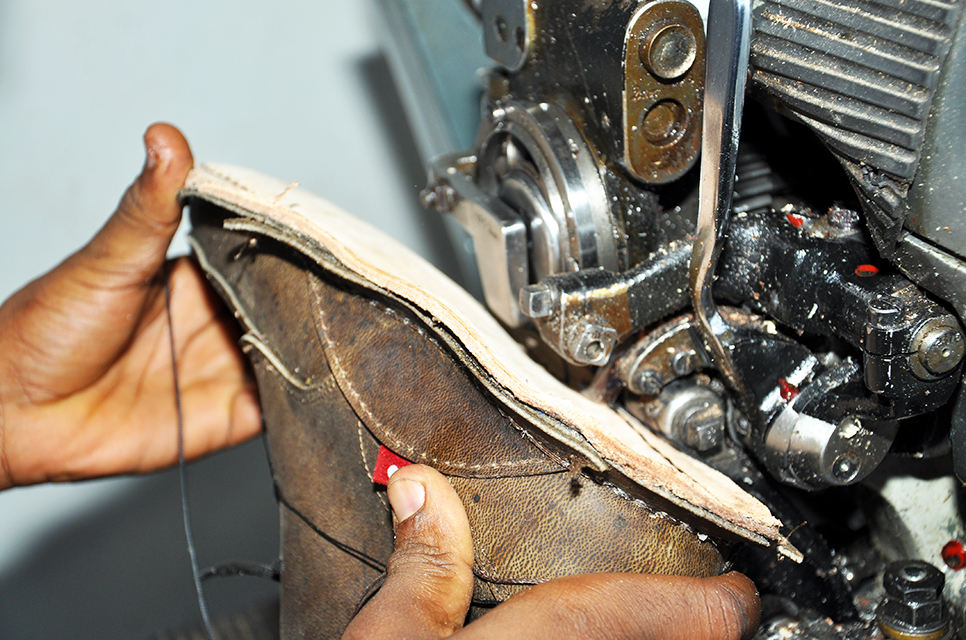
Everything has a story, even if it’s not being told. Every product you buy was sewn somewhere. It was designed by someone. It was inspected, packaged, shipped by hand. We’re extremely proud of the story behind our goods. The basics? Leather: African. Rubber: African. Handcrafting skills: Ethiopian. But it goes beyond these components, down to the very construction of our styles. One such element: The stitchdown, invented in Africa.
The stitchdown is how the upper leather is stitched to the midsole and sole of the shoe. We like this look because it makes for a rugged vibe and water resistant function. It also defines a shoe that is made to last. Below, one of our team members in Ethiopia shows how it’s done:

But we are far from the first to make use of this technique. The story dates back to the traditional footwear of the Khoisan, who were the first inhabitants of the sub-Saharan African bush, and who still live amid the arid land today. European settlers in the area observed the construction and incorporated it into their own simple shoe style that could hold up to their settler lifestyle and tough terrain – prickly acacia trees, arid plains, high grasses – a shoe known in Africaans as “the Veldtschoen,” which translates roughly to “bush” (veldt in Afrikaans) “shoe” (schoen in old Dutch) and is simplified to “vellie”.

The vellie is now a staple shoe style in both South Africa and Namibia. Outside of Africa, it became widely known with its desert boot debut for WWII – this time on British soldiers. In parts of East Africa, it’s known as the safari boot. In the 1960s, it found a new home with beatnik generation in the US. Chukka boots, vellies, desert boots, safari boots – all these styles celebrate the stitchdown to this day. And now we’re making it our own.
Photos of stitchdown and shoes at the Oliberté factory by Ethiopian photographer Kinfe Sahlu Gulte, owner of Kinfe Film Production.
 Everything has a story, even if it’s not being told. Every product you buy was sewn somewhere. It was designed by someone. It was inspected, packaged, shipped by hand. We’re extremely proud of the story behind our goods. The basics? Leather: African. Rubber: African. Handcrafting skills: Ethiopian. But it goes beyond these components, down to the very construction of our styles. One such element: The stitchdown, invented in Africa.
The stitchdown is how the upper leather is stitched to the midsole and sole of the shoe. We like this look because it makes for a rugged vibe and water resistant function. It also defines a shoe that is made to last. Below, one of our team members in Ethiopia shows how it’s done:
Everything has a story, even if it’s not being told. Every product you buy was sewn somewhere. It was designed by someone. It was inspected, packaged, shipped by hand. We’re extremely proud of the story behind our goods. The basics? Leather: African. Rubber: African. Handcrafting skills: Ethiopian. But it goes beyond these components, down to the very construction of our styles. One such element: The stitchdown, invented in Africa.
The stitchdown is how the upper leather is stitched to the midsole and sole of the shoe. We like this look because it makes for a rugged vibe and water resistant function. It also defines a shoe that is made to last. Below, one of our team members in Ethiopia shows how it’s done:
 But we are far from the first to make use of this technique. The story dates back to the traditional footwear of the Khoisan, who were the first inhabitants of the sub-Saharan African bush, and who still live amid the arid land today. European settlers in the area observed the construction and incorporated it into their own simple shoe style that could hold up to their settler lifestyle and tough terrain – prickly acacia trees, arid plains, high grasses – a shoe known in Africaans as “the Veldtschoen,” which translates roughly to “bush” (veldt in Afrikaans) “shoe” (schoen in old Dutch) and is simplified to “vellie”.
But we are far from the first to make use of this technique. The story dates back to the traditional footwear of the Khoisan, who were the first inhabitants of the sub-Saharan African bush, and who still live amid the arid land today. European settlers in the area observed the construction and incorporated it into their own simple shoe style that could hold up to their settler lifestyle and tough terrain – prickly acacia trees, arid plains, high grasses – a shoe known in Africaans as “the Veldtschoen,” which translates roughly to “bush” (veldt in Afrikaans) “shoe” (schoen in old Dutch) and is simplified to “vellie”.
 The vellie is now a staple shoe style in both South Africa and Namibia. Outside of Africa, it became widely known with its desert boot debut for WWII – this time on British soldiers. In parts of East Africa, it’s known as the safari boot. In the 1960s, it found a new home with beatnik generation in the US. Chukka boots, vellies, desert boots, safari boots – all these styles celebrate the stitchdown to this day. And now we’re making it our own.
Photos of stitchdown and shoes at the Oliberté factory by Ethiopian photographer Kinfe Sahlu Gulte, owner of Kinfe Film Production.
The vellie is now a staple shoe style in both South Africa and Namibia. Outside of Africa, it became widely known with its desert boot debut for WWII – this time on British soldiers. In parts of East Africa, it’s known as the safari boot. In the 1960s, it found a new home with beatnik generation in the US. Chukka boots, vellies, desert boots, safari boots – all these styles celebrate the stitchdown to this day. And now we’re making it our own.
Photos of stitchdown and shoes at the Oliberté factory by Ethiopian photographer Kinfe Sahlu Gulte, owner of Kinfe Film Production.





